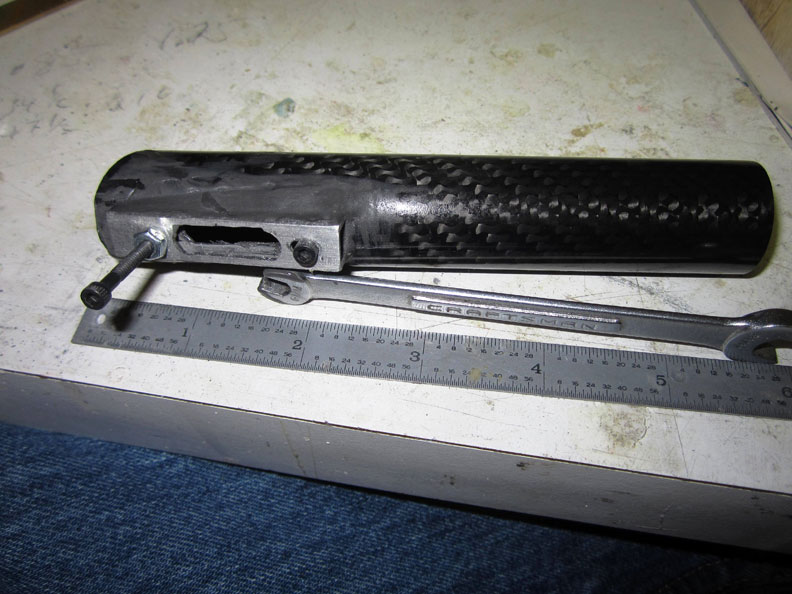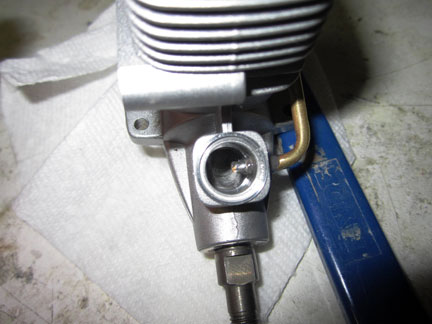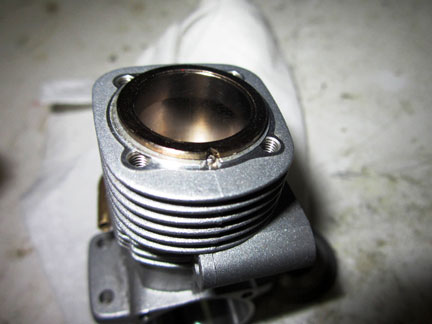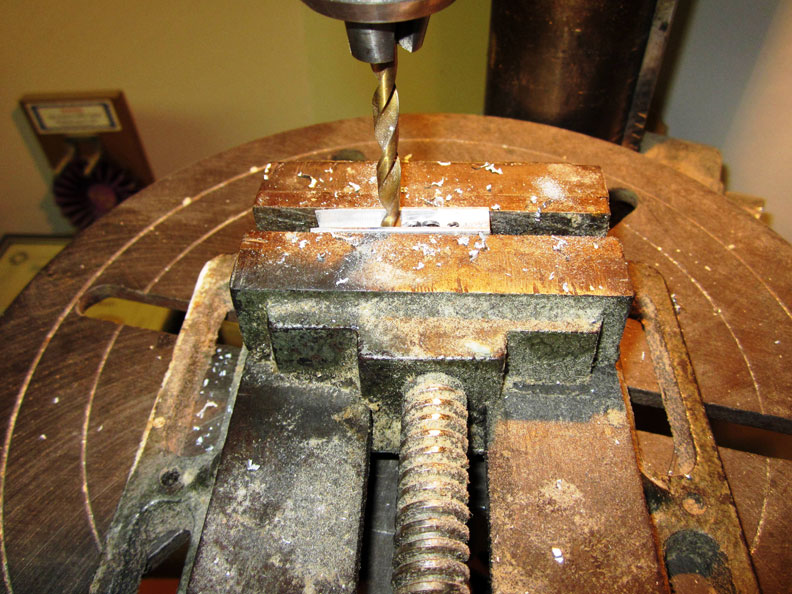A View from Broadway
O.S. LA .25 for Northwest B Proto (Geezer) Speed
A Geezer of an engine
(Part 1 of 2)
By Ken Burdick
Yes Folks, it's true.
I'll give you my impressions as I go from start to finish in a progressive manner, so I may be less than impressed at first.
We begin.
First blush
The O.S LA .25 is a geezer of an engine. I've owned my share of binding Foxes, Enyas that quit inverted, TeeDees that blow up and many a stupidly slow d-bat motor, but until now I have never encountered a bowser quite like this one. To say that it's slow gives new meaning to the word; I've had turtles faster than this.
I blame the Hippie!
Fine, Just great, the doggone Hippie talks me into flying this thing in a speed event -- rest assured, no one is going to topple over in the pylon flying one of these things. There, I feel better now, so let's get busy, OK?
Filled with the newness of a challenge, I sent away for two of the little one lugers, one to be “pure stock” while the other was to be measured and made better by Batman.
Batman?
 Batman was the engineer at the factory that made the Cox Conquest finally work for them. He has set AMA speed records, made his own castings and built his own engines.
Batman was the engineer at the factory that made the Cox Conquest finally work for them. He has set AMA speed records, made his own castings and built his own engines.
Batman, aka Bruce Tunberg, was enjoying his retirement until I sent him an email asking for help with my “little project” What a good sport he is. He made a backplate and a larger venturi and set the head in a reasonable compression range for the little engine that thought it could.
A special trip was planned from a foreign country back to the U.S. just to pick up the engines, then a mad dash to the Bod Buster R&D lab for the initial break-in runs. The Rein Man was watching golf when I arrived, dragged out the dyno (sawhorse with an aluminum mount attached to it) and we began this phase of The Geezers speed engine.
Break-in
The factory instructions were followed, so I used Powermaster 10% nitro/18% oil and each engine was run three times, five minutes each on a 9x5 wooden prop. First at a rich two-cycle that we leaned out slightly with each tank, then checked with the BBB tachometer to see what the results were. The factory muffler was used partially for the additional heat and partially for the RPM baseline, but mostly for the neighbors.
The stock engine hand-started poorly because of the muffler. The same was done for the Batman engine, which started even more poorly, due to the high-compression head. The results were geezerly spectacular.
- Stock engine max rpm 10,400
- Batman engine max rpm 10,800.
Golldurn Hippie -- NOW LOOK WHAT'S HAPPENED! This is going to be difficult.
Let's get dirty
We'll try a variety of changes on both bowsers and record the results here. On initial inspection, the LA .25 looks reasonable. Nice piston fit, smallish but well-made crankshaft, nice bronze main bearing complete with oiling groove, bushed conrod with dual oiling holes at the bottom end. Dual liner intake ports with lots of room for adding boost ports.
The cylinder head is unfortunately one piece, making modifications more difficult than a two-piece clamp with an insert. The smallish venturi has a gigantic spray bar running through it.
Areas of potential improvement
All of the things I don't like will be potential RPM gains for us. I'm going to make things easy there geezers, so don't think you'll need a machine shop. Let's keep reading and find out how.
- Venturi/breathing
- Spray bar
- Cylinder head
- Crankshaft
- Porting
- Magic
Head work
The cylinder head had .020 removed so as to increase compression and without gasket set at 0.00 clearance from the piston. Note: The engine was not run with 0.00 clearance. The reason for this is with any head gasket, you will know exactly the head clearance from the piston.
The stock venturi was increased from .250 to .281 Note: Engine still will run on suction.
Muffler removed, 9x5 break-in prop. Fuel: 10% Powermaster.
- RPM 12,000 (Batman engine)
- RPM 12,400 larger venturi (Batman engine)
- RPM 11400 (stock engine)
Our focus will be on the faster engine with a final A-B comparison later.
Prop changed to our “test prop” 8x7 Top Flite speed prop cut to 7x7.
- RPM 16,100 (Batman engine)
Now we're getting somewhere, geezers. Only 900 RPM from the factory stated max of 17,000 RPM.
The following changes were made to the Batman engine only, with RPM recorded using the 7x7 prop:
- Venturi increased to .281: 16,100 rpm
- Venturi removed -- .385, pressure fuel system used: 17,200 rpm
- Spray bar changed to stub entry, pressure fuel system, crankshaft port contouring (JB Weld), set head .010 from piston, liner raised .010: 18,400 rpm
- Mini pipe (oh crap, see final notes)
Well, lil' geezers, we more than did it. The max factory RPM was 17,000 and we hit 18,400. Not a bad increase considering the baseline was 10,800. A 6,200 RPM gain from the out-of-the-box engine.
The largest single gain came from removing the muffler. The next largest gain was opening up the venturi and running a pressure system. The glow plug was changed from a O.S. short to a K&B standard with no perceivable gain in performance.
I removed the venturi from the pure stock engine and made an A-B comparison of the two engines.
- Stock engine 17,200 rpm
- Modified engine 18400 rpm
It appears the Batman head and raising the liner made a nice difference. I don't think the crankshaft contouring made any significant increase to performance, but I did it at the same time as the timing change so there is no measurement.
The timing change was made by using a Fox .35 head gasket (.010 thick) a perfect fit. Be sure to notch it for the locating pinon the top flange of the case.
Mini-pipe
Well, why not a mini-pipe? I can think of a few good reasons such as:
- I don't really understand them.
- I'm not a machinist and this thing is a side exhaust.
- I don't have any aluminum tubing here in the wilds of Kamloops.
All that nay-saying aside, I did pick up some scrap carbon fiber tubes at the swap meet in Monroe, so let's give it a try.
First thing is how big should it be? I studied tuned cavities for high-freq in microwave, but this is pretty low-frequency stuff. I know, I'll ask Luke Roy (H&R Rattler engine designer) if it was his formula I saw once. Turns out it was and he sent me a link to his site.
In the “calculations portion there it was -- MINI-PIPE. I plugged in the numbers and got this:
Displacement 0.2487
- Pipe length to piston face (inches): 5.1786
- Pipe length to C/L bore (inches): 5.5331
- Pipe inside diameter (inches): 0.7820
The pipe I had was slightly bigger in diameter than the .7820, but then it's not an exact set of variables that I'm working with here so we'll pretend this is horseshoes and use what I have. To quote Mr. Roy, “this should get you close.”
The first stumbling block was how to make a manifold to connect to the engine. No lathe or mill here, just a drill press and JB Weld. I was going to make the manifold out of brass and glue it to the tube, and then mill it out using the drill press. Once I weighed the brass, I changed my mind and scared up a broken F2D engine mount beam. It turned out to be just the right width for mating to the engine stack.

Hacksaw at work, I soon fabricated the piece and used JB Weld to attach it to the tube. When cured, I drilled several holes for the exhaust then filed them out for the exhaust hole. Located and drilled the mounting holes and epoxied 4-40 nuts in place so the whole mess can be mounted to the engine.*(picture of the finished pipe)
I have no idea if this is going to work, but we'll do a tach reading in a couple of days, OK? Gotta let the glue dry. The open end of the tube was closed with a CA- coated piece of basswood and epoxied in place, then a wrap of epoxy-coated fiberglass cloth around the end to keep our lil' plug from doing its own flying.
My general disposition over this engine has improved. What once was a floater in the punchbowl is now running at decent RPM on a prop that might be close to what I will use. My final goal for it is around 20,000 rpm, but that's a ways off still. The mini-pipe weighed in less than an ounce, so if it adds to the top end, it will be worth the added weight.
Blue Monday
OK, I'm back from running the mini-pipe -- mad as heck.
No, it wasn't because it didn't work, and it wasn't because of poor performance on the part of the engine either. I had finally got the balky thing running and was reaching for the tach when el motor pulled the saw horse over!.
*Shaking my head.* I guess it must have been at an angle and the legs were a narrow stance to begin with. I just never expected such a thing. Fortunately, I was out of the way and the only damage was to my reference prop! I don't have another one. All I can tell you is it sounded fast and high pitched. Just short of meaningless without a reading.
So there you go, lil' geezers, with some simple work, you can get your O.S. LA .25 up in the 18,000-19,000 RPM range.I do think it's a bit sensitive to props though and the range it likes to run in is the 7 to 7-1/2 inch diameter and 7 to 7-1/2 inch pitch. Just from observations and no empirical data, I believe that some subport induction will push it over the 19,000 RPM range into the Hippie's belief of 20,000. This may open the way for a slightly larger gulp of fuel and the crank port might benefit from more duration, but that's for another day.
-- kennyb
More photos
Spray bar replaced by stub (above and below left).


Above right, the liner shim.

Making the manifold for the mini-pipe.

Welding the mini-pipe.
Back to Bod Busters main page
Back to Speed main page
Flying Lines home page
This page was upated April 7, 2015

